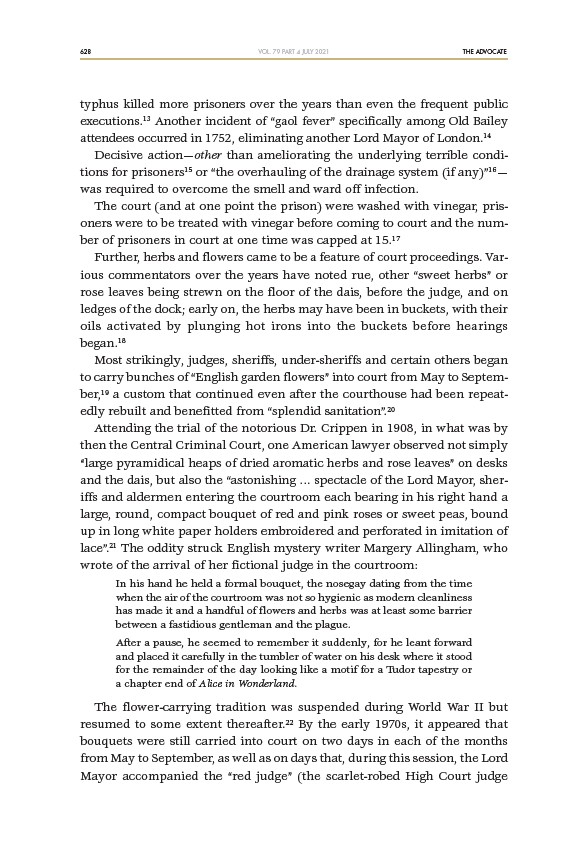
628 THE ADVOCATE
VOL. 79 PART 4 JULY 2021
typhus killed more prisoners over the years than even the frequent public
executions.13 Another incident of “gaol fever” specifically among Old Bailey
attendees occurred in 1752, eliminating another Lord Mayor of London.14
Decisive action—other than ameliorating the underlying terrible conditions
for prisoners15 or “the overhauling of the drainage system (if any)”16—
was required to overcome the smell and ward off infection.
The court (and at one point the prison) were washed with vinegar, prisoners
were to be treated with vinegar before coming to court and the number
of prisoners in court at one time was capped at 15.17
Further, herbs and flowers came to be a feature of court proceedings. Various
commentators over the years have noted rue, other “sweet herbs” or
rose leaves being strewn on the floor of the dais, before the judge, and on
ledges of the dock; early on, the herbs may have been in buckets, with their
oils activated by plunging hot irons into the buckets before hearings
began.18
Most strikingly, judges, sheriffs, under-sheriffs and certain others began
to carry bunches of “English garden flowers” into court from May to September,
19 a custom that continued even after the courthouse had been repeatedly
rebuilt and benefitted from “splendid sanitation”.20
Attending the trial of the notorious Dr. Crippen in 1908, in what was by
then the Central Criminal Court, one American lawyer observed not simply
“large pyramidical heaps of dried aromatic herbs and rose leaves” on desks
and the dais, but also the “astonishing … spectacle of the Lord Mayor, sheriffs
and aldermen entering the courtroom each bearing in his right hand a
large, round, compact bouquet of red and pink roses or sweet peas, bound
up in long white paper holders embroidered and perforated in imitation of
lace”.21 The oddity struck English mystery writer Margery Allingham, who
wrote of the arrival of her fictional judge in the courtroom:
In his hand he held a formal bouquet, the nosegay dating from the time
when the air of the courtroom was not so hygienic as modern cleanliness
has made it and a handful of flowers and herbs was at least some barrier
between a fastidious gentleman and the plague.
After a pause, he seemed to remember it suddenly, for he leant forward
and placed it carefully in the tumbler of water on his desk where it stood
for the remainder of the day looking like a motif for a Tudor tapestry or
a chapter end of Alice in Wonderland.
The flower-carrying tradition was suspended during World War II but
resumed to some extent thereafter.22 By the early 1970s, it appeared that
bouquets were still carried into court on two days in each of the months
from May to September, as well as on days that, during this session, the Lord
Mayor accompanied the “red judge” (the scarlet-robed High Court judge